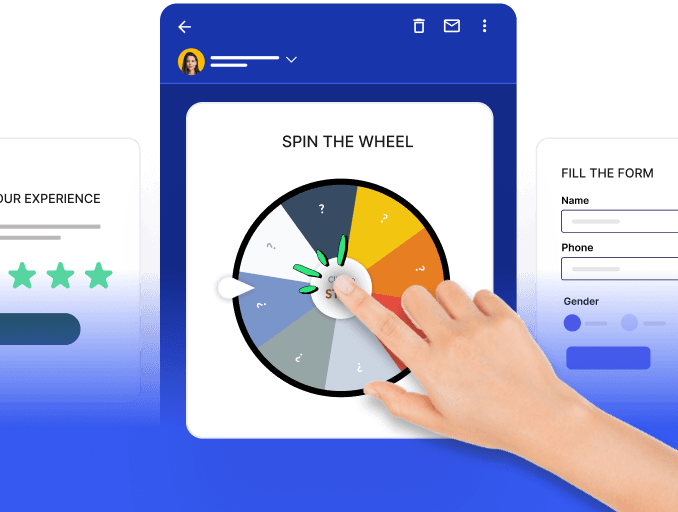In the fast-paced world of ecommerce, success hinges on understanding your customers and what drives sales. This is where Key Performance Indicators (KPIs) come in. In this blog, we'll delve into the significance of KPIs for ecommerce businesses, essential eCommerce KPIs, and tools that will revolutionize how you do business in 2024.
So, let's dive in and learn how to choose the right ecommerce KPIs to track in 2024.
Table of contents
What are key performance indicators (KPIs)?
Ecommerce KPIs, or key performance indicators, are metrics that businesses use to measure the success of their online operations. These metrics provide valuable insights into various aspects of an ecommerce business, such as sales performance, customer engagement, marketing efficiency, and customer satisfaction. By monitoring these KPIs, you gain a clear picture of what's working and what's not, allowing you to make data-driven decisions that drive growth for your online business.
There are various ecommerce KPIs that businesses can track, depending on their specific goals and objectives. Some common examples of ecommerce KPIs include total revenue, average order value, customer retention rate, etc.
By regularly tracking and analyzing these KPIs, businesses can gain a deeper understanding of their performance, identify trends and patterns, and take proactive steps to improve their overall ecommerce operations.
Key performance indicators for ecommerce business
Let’s take a look at some of the most important KPIs that you would want to track if you’re looking to grow your ecommerce business. We’ve also divided these metrics into the following:
Sales metrics
- Revenue: This is the total amount of money your business generates from sales. Revenue is the lifeblood of your business and the ultimate gauge of your ecommerce success. Tracking revenue trends over time and across different channels gives you invaluable insights into your business's financial health and growth trajectory.
- Conversion rate: This metric reveals how effective your website is at turning visitors into paying customers. A higher conversion rate means more revenue per visitor. It's calculated by dividing the number of sales by your total website traffic (visitors).
- Average order value (AOV): This is a key ecommerce metric that tells you the average amount a customer spends per order. A higher AOV signifies increased customer engagement and a boost to your bottom line.
- Customer lifetime value (CLV): This metric looks beyond a single purchase. It estimates the total revenue a customer brings to your business throughout their relationship with your brand. Understanding the long-term value of each customer helps guide your marketing and retention strategies.
Marketing Metrics
- Cost per acquisition (CPA): This metric reveals how much you spend to acquire a new customer. Imagine you spend $10 on a social media ad campaign that brings in 5 new customers. Your CPA would be $2 per customer. Optimizing your marketing efforts can help lower your CPA. A lower CPA means more efficient customer acquisition.
- Return on advertising spend (ROAS): This metric goes beyond cost and shows the actual return you get on your marketing investments. Let's say you spend $100 on ads and generate $200 in sales from those ads. Your ROAS would be 2 (Revenue Generated from Ads / Ad Spend). A higher ROAS indicates effective marketing campaigns.
- Click-through rate (CTR): This metric shows the percentage of people who click on your ads or calls to action like "Buy Now" buttons or links in your marketing emails. A high CTR indicates your marketing messages are resonating with your target audience.
- Conversion rate of different pages: Picture each page on your website as a unique gateway to conversions. Analyzing conversion rates of different pages helps you identify high-performing areas and optimize underperforming ones for better results.
- Traffic from different sources: Envision a diverse ecosystem of traffic sources, from organic search to social media referrals. Understanding where your traffic comes from enables targeted marketing efforts and enhances customer acquisition strategies.
Customer service metrics
- Customer satisfaction score (CSAT): This metric gauges customer satisfaction with their overall experience, often measured through surveys after purchases or interactions with customer service.A high CSAT score indicates happy customers who are more likely to return.
- Net promoter score (NPS): This metric goes a step further than CSAT. It measures how likely your customers are to recommend your brand to others. A high NPS indicates loyal customers who are brand advocates.
- Response time: This kpi measures how quickly your customer service team is responding to inquiries. Businesses can monitor the average amount of time taken to respond to customers' inquiries. This helps you deliver exceptional customer service and foster trust and loyalty among your audience. Faster and timely responses to customer inquiries can enhance customer satisfaction and retention.
- No. of tickets closed: This metric looks at the volume of customer support tickets resolved within a specific timeframe. A high closure rate indicates your team is efficiently handling customer issues.
Operational Metrics
- Inventory turnover: This measures how often you sell through your entire stock. A healthy inventory turnover rate ensures you have enough products in stock to meet demand without tying up too much capital in stagnant inventory.
- Order fulfillment time: This measures the time it takes for an order to be processed and shipped to the customer. Monitoring order fulfillment time ensures efficient operations and enhances the customer experience. Faster fulfillment times lead to happier customers and improved customer satisfaction.
- Return rate: This metric reveals the percentage of orders that are returned. While some returns are inevitable, a high return rate can indicate issues with product quality, sizing, or unclear descriptions. Tracking return rates help you identify product or service issues early and take corrective actions to maintain customer satisfaction
Financial Metrics
- Gross profit margin: This metric reveals the profit you make after subtracting the cost of goods sold (COGS) from your revenue. A healthy gross profit margin ensures your business is profitable after accounting for the direct costs of your products.
- Operating expenses ratio: This metric tells you what percentage of your revenue is eaten up by operating expenses (rent, salaries, marketing, etc.). Understanding this ratio helps you identify areas where you can potentially cut costs and improve profitability.
- Annual recurring revenue: This shows the predictable income you can expect each year from subscriptions or contracts. Annual recurring revenue provides a stable foundation for your business's financial stability and growth projections.
How to choose the right kpis for your ecommerce business
It’s easy to say that you must track all the KPIs that are important for your ecommerce business. However, it’s not as easy to define the KPIs that need to be tracked. It takes a lot of planning and thought to finalize the right KPIs that will allow you to see if your business goals are being met. Here’s how you can choose the right KPIs:
1. Understand business goals and objectives
Before choosing the right ecommerce KPIs to track, it's important to identify your business goals and objectives. These goals will guide your decision-making process and help you determine which metrics are most relevant to your business. Are you aiming to increase online sales, improve customer retention, or enhance operational efficiency? Each goal will have its set of relevant KPIs that directly contribute to achieving it. For instance, if your goal is to boost sales, KPIs such as conversion rate, average order value (AOV), and customer lifetime value (CLV) will be paramount.
2. Set clear targets
Setting clear and achievable goals is essential for the success of your ecommerce business. When setting goals, it's important to be specific and define them within a specific period of time. These targets serve as milestones, indicating whether you're on track or need adjustments. For example, instead of setting a goal to increase sales, set a goal to increase sales by 10% within the next quarter or you may set a target of increasing your Conversion rate by 15% within the next quarter or improving your AOV by $20 per transaction.
In addition to being specific, goals should also be achievable. Consider your resources, budget, and current performance when setting goals. Setting unrealistic goals can lead to frustration and demotivation. Furthermore, goals should be aligned with your overall business strategy and take into account the total cost and resources required to achieve them. By setting clear, achievable goals, you can track your progress and make strategic decisions to drive the success of your ecommerce business.
3. Align kpis with key business objective
To effectively track and measure the success of your ecommerce business, it's important to align your KPIs with your business objectives. This alignment ensures that you are tracking the metrics that are most relevant to achieving your goals.
For example, if your business objective is to increase customer acquisition, you may want to track metrics such as website traffic, conversion rate, and customer acquisition cost. These metrics provide valuable insights into your marketing strategies and help you make data-driven decisions to drive customer acquisition.
Similarly, if your objective is to improve your bottom line, metrics such as average order value, customer lifetime value, number of orders, and net profit can provide valuable insights into the financial performance of your ecommerce business. By aligning your KPIs with your business objectives, you can track your progress and make informed decisions to achieve your goals.
4. Prioritize actionable and measurable kpis
The best KPIs are clear, quantifiable, and actionable. They should provide insights that directly translate into improvements for your business.
Avoid Vanity Metrics: Don't get caught up in "feel-good" metrics that don't directly impact your goals. Having a million followers on social media is great, but what matters is how many of them convert into sales.
Focus on Trends, Not Just Numbers: Looking solely at a single data point won't tell the whole story. Track your KPIs over time to identify trends and make adjustments to your strategy accordingly
Tools and technologies for tracking ecommerce kpis
There are numerous metrics and KPIs to track when it comes to tracking the overall success of your ecommerce business. Likewise, there are numerous tools to help you do that. Here are some common tools and technologies that you might want to use:
- Google Analytics: This is a must-have tool for tracking website traffic, user behavior, conversions, and more. With Google Analytics, you can gain valuable insights into how visitors interact with your site, which products are performing well, and where improvements can be made.
- Ecommerce platforms with analytics: Platforms like Shopify, Magento, WooCommerce, and others offer built-in analytics and reporting functionalities. These platforms not only help you manage your online store but also provide valuable data on sales, customer behavior, and inventory management.
- Customer data platforms (CDPs): CDPs like Segment, BlueConic, and Tealium help aggregate and unify customer data from various sources. By centralizing customer data, you can create more personalized experiences, track customer journeys, and measure the impact of your marketing efforts.
- Customer success tools: Tools like Zendesk, Freshdesk, and Intercom are essential for managing customer inquiries, feedback, and support tickets. They allow you to track metrics such as response time, ticket resolution rate, and customer satisfaction scores and can help you improve customer service and retention.
- Business intelligence (BI) tools: BI tools like Tableau, Power BI, and Google Data Studio enable you to visualize and analyze data from multiple sources. These tools can help you identify trends, patterns, and opportunities for growth, making data-driven decision-making easier.
Conclusion
By effectively utilizing ecommerce KPIs, you gain a comprehensive understanding of your online store's performance and can make data-driven decisions that drive growth and success. Remember, KPIs are not set in stone. Regularly evaluate your chosen metrics, adjust them as needed, and leverage data visualization tools to gain deeper insights. With the right KPIs and a commitment to data analysis, you can transform your ecommerce business and ultimately drive growth.







